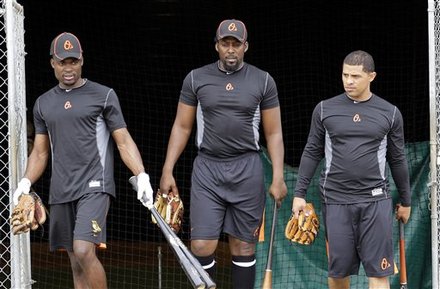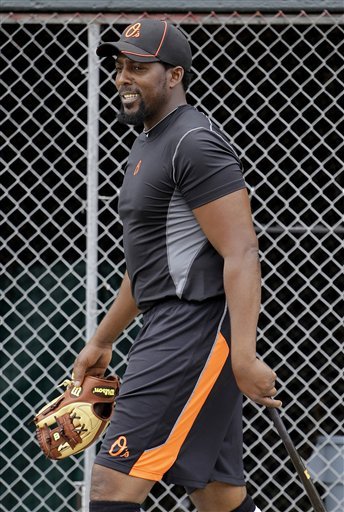

Moderator: mods
Minor League contract en shoulder issues. We hebben al genoeg bouwpakketten. In 2010 6.10 ERA en een 1-3 record. Met Perez was Maine de sucker van vorig jaar.InnerHarbour schreef:Main naar de Rockies, zitten jullie niet om pitching verlegen?
Oeps.PORT ST. LUCIE, Fla. -- The Mets have received a loan from Major League Baseball to deal with "a short-term liquidity issue."
The Mets issued a statement on Friday: "We said in October that we expected to have a short-term liquidity issue. To address this, we did receive a loan from Major League Baseball in November. Beyond that, we will not discuss the matter any further."
The statement was issued after a New York Times story said the amount of the loan from MLB to the Mets was at least $25 million. The team declined comment on the figure.
Mets owner Fred Wilpon and his business partner, Saul Katz, are fighting a $1 billion lawsuit from Irving Picard, the trustee charged with recovering profits earned through Bernard Madoff's Ponzi scheme.
The Wilpon family announced earlier this month that it was considering selling up to 25 percent of the team as a result of the lawsuit.
From today's NY Post:
JUPITER, Fla. - In a few weeks, baseball's labor poobahs will sit down together and begin talks on a new collective bargaining agreement. The principal issues - revenue sharing, cost containment in the draft - are a prelude to bigger ones down the road, specifically: Schedule inequities, the seemingly hopeless stadium situations in Tampa Bay and Oakland, the fate of the designated hitter and Bud Selig's longtime musing, geographic re-alignment.
While none of those latter issues is on the labor agenda, people all over baseball are talking about them. Orioles manager Buck Showalter says he stays up nights configuring Realignment scenarios that would solve a lot of baseball's problems.
"It's just not right the way it is with teams in the same divisions not playing the same schedules," Showalter said, in reference to interleague play in particular, which has created a myriad of inequities such as the St. Louis Cardinals drawing the Orioles, Blue Jays and two series with the Royals this year while the Cubs, in their same division, have to play the Yankees, Red Sox and two series against their intracity rival White Sox. "Why not," asked Showalter, "have everyone in baseball play everyone the same amount of games - three home, three away?"
Showalter acknowledged that to do this, baseball would have to contract two teams and then form four seven-team divisions. Each team would play six games against all 27 opponents. That works out to 162 games. There are also inherent problems with every team playing each other. One is travel and the other is it defeats the purpose of geographic re-alignment, which is to play as many games as possible in your own time zone. Still, four divisions of seven makes for easier schedule scenarios.
"Going to four divisions of seven would also force us to make a decision on the designated hitter," Showalter said. "Either everybody has it, or nobody has it. It's really dumb, the leagues today playing with two sets of rules."
While Showalter chose not to be specific about contraction, other than to reiterate how 28 teams is a much more workable number when it comes to scheduling and re-alignment, there is a growing sentiment for it throughout baseball, especially in regard to the Rays and A's. At least three baseball executives targeted those two teams as the most logical ones for extinction. "It's pretty clear," said one, "that neither of those teams can continue to operate in those facilities." Added another exec: "How much longer can you expect all the other teams to subsidize two teams, in futile situations, with revenue sharing to keep them afloat?" A third exec was even more emphatic: "The biggest mistake we ever made was expanding into Florida. The Rays are hopeless, and I have serious doubts about the Marlins surviving in that new stadium of theirs."
And according to one high-level baseball source, both Rays owner Stuart Sternberg (whose efforts to move the team out of the Tropicana Field dome in St. Pete to a retractable roof facility in Tampa are meeting the two-fold obstacles in the depressed Florida economy and the intractable St. Petersburg bureaucrats), and A's managing partner Lew Wolff (who has pleaded, to no avail, with baseball to lift the Giants' territorial rights claim on San Jose) have told Selig they are not prepared to continue operating under the present circumstances. Translation: "If we can't get new stadiums, buy us out."
According to the latest Forbes team values figures, the A's and Rays are worth approximately $320 million each. Figuring $700 million as the price for contracting them both, it would cost each approximately $25 million to buy them out.
MLB can unilaterally contract teams but must collectively bargain the effects of contraction with the union - specifically the loss of those 50 jobs and what becomes of those players. Those issues could be resolved, however, by the expansion of the rosters from 25 to 27 players, and having the approximately 250 players from the two contracted organizations redistributed among the 28 teams by virtue of a draft. Those players with guaranteed long-term contracts would have the right to be exempt from the draft and opt for free agency. If they chose the former and were not drafted, MLB would then have to make good on their contracts out of its central fund.
Another related inequity which baseball has failed to address is the expansion of the rosters in September, in which there is currently no limit to the number of players a team can call up. With rosters expanded to 27, September call-ups could be limited to three players per team - but with the stipulation only 27 could be active for each game.
Cardinals manager Tony La Russa, who is on Selig's 14-member baseball study commission, said that, while he has known nothing but the 25-man roster his entire life, considering how pitching has evolved, with clubs routinely carrying 13 pitchers (as opposed to nine-10, years ago), he can see the merits of adding a couple of extra players to the roster. "If you have the DH, you don't need that much of a bench," La Russa said. "But if you get rid of the DH, and you're carrying 13 pitchers, that really straps you, especially since one of your four bench players is the back-up catcher."
Using a consensus of the half-dozen managers and executives surveyed for this exercise, here's how baseball could evolve over the next 10 years:
Geographically realigned divisions: Seven teams, four divisions
Designated hitter: Grandfathered for three years under the new four-division format, then goes away.
Rosters: Expanded to 27 with a limit to three September call-ups and the stipulation that only 27 players, to be designated by the manager before each game, can be active.
For the now, however, look for the biggest changes coming out of the next collective bargaining agreement to be a bonus slotting system in the draft and the ability of clubs to trade draft picks.
Tweede wedstrijd, eerste HR.Vladimir Guerrero homers (1) on a fly ball to left field. One out
Tuesday, March 1, 2011
Report: Mets need another loan
By Adam Rubin
ESPNNewYork.com
Days after the New York Mets acknowledged obtaining a loan from Major League Baseball to address liquidity issues, the team's embattled owners are desperately searching for another bank loan to cover basic operating expenses, the New York Post reported on Tuesday.
MLB and the ballclub are "exerting strong pressure" on JPMorgan to provide additional money until a minority ownership partner can be secured to infuse cash, the Post reported. Reports indicate the Mets already have $430 million in bank loans, plus the $25 million borrowed in November and another $50 million previously borrowed from MLB.
Principal owner Fred Wilpon and his family also are defendants in a $1 billion lawsuit brought by the trustee trying to recover funds for victims of convicted swindler Bernard Madoff's Ponzi scheme.
Wilpon announced his intention to sell 20 to 25 percent of the ballclub to raise cash. Steve
Greenberg, hired by the family to locate a minority partner, since has said a higher percentage could be sold, but not a controlling interest.
Mets owners have said they are pursuing avenues of raising money beyond selling a portion of the team, and trying to secure an additional lone is one avenue to achieve that.
The Post quoted one source saying JPMorgan "believe[s] the Mets still have a capacity to borrow," despite their existing debt load and the pending litigation. Another source told the newspaper: "Are you kidding me? You don't lend into a distressed situation. This is a very risky loan."
JPMorgan is also being sued by Irving Picard, the trustee for Madoff victims, who is seeking $6.4 billion. Picard claims the institution should have known that Madoff was perpetrating fraud. The firm denies the allegations.
Adam Rubin covers the Mets for ESPNNewYork.com. You can follow him on Twitter.
Ollie Perez weet het met 'succes' te voorkomen.GangstaRiB schreef: Heb laatst ook een boekje gelezen (Leander Schaerlaeckens, De Amerikaanse Sportdroom) waarin duidelijk wordt wat voor een wereld het baseball is. Zonder pardon wordt je teruggezet naar triple-A of double-A teams met minder vergoeding en je vliegt jezelf een ongeluk.
AVG en RBI zijn natuurlijk nog steeds handige statistieken, maar ze zijn inmiddels stukken verder.Dubbel schreef: Verder heeft GangstaRiB natuurlijk helemaal gelijk dat er door clubs en fans vooral naar AVG, OBP, RBI en HR wordt gekeken en dat is niet altijd goed. Iemand als Bobby Abreu is een prima slagman maar als je daar de punten vanaf trekt die hij kost door slecht veldspel dan krijg je een veel realistischer beeld.